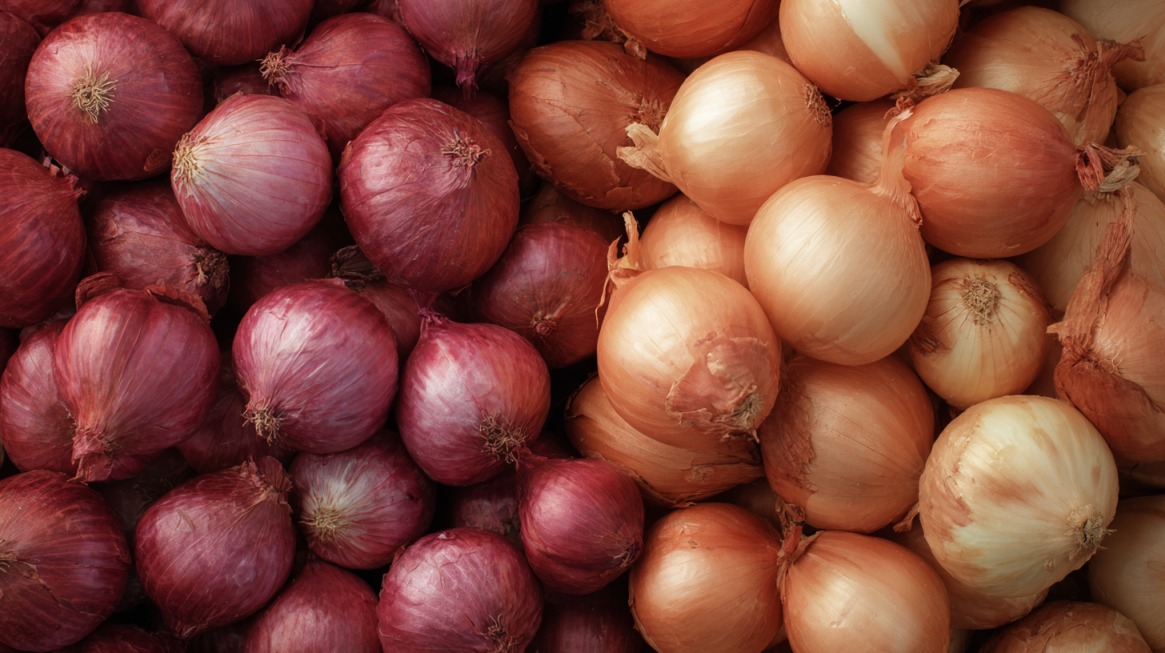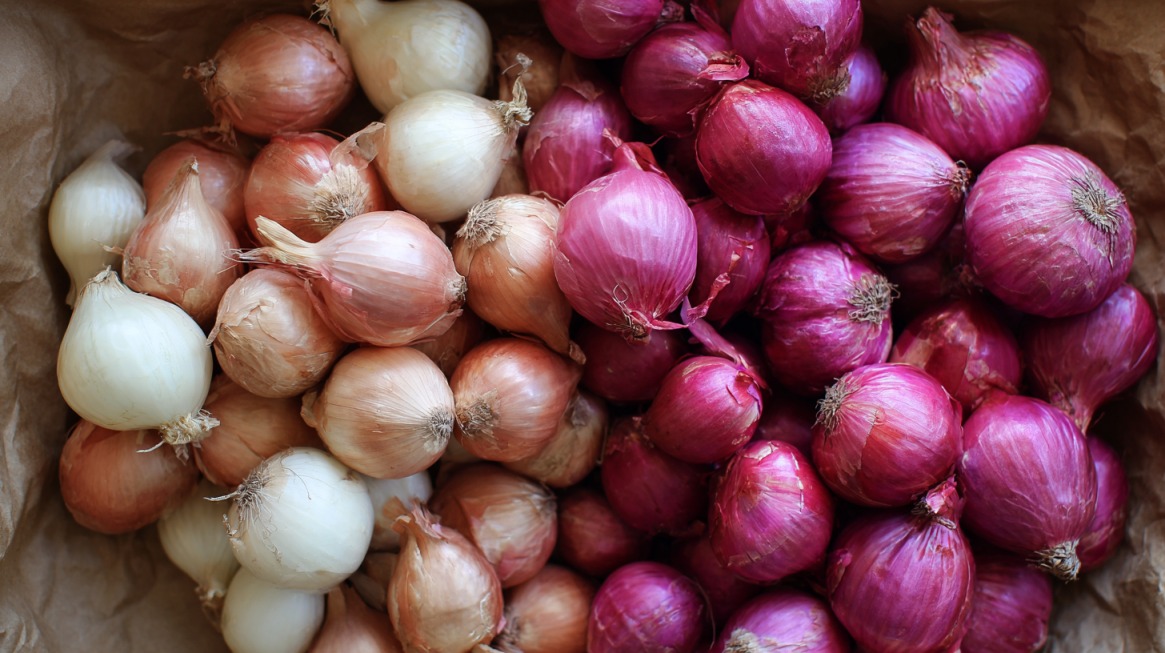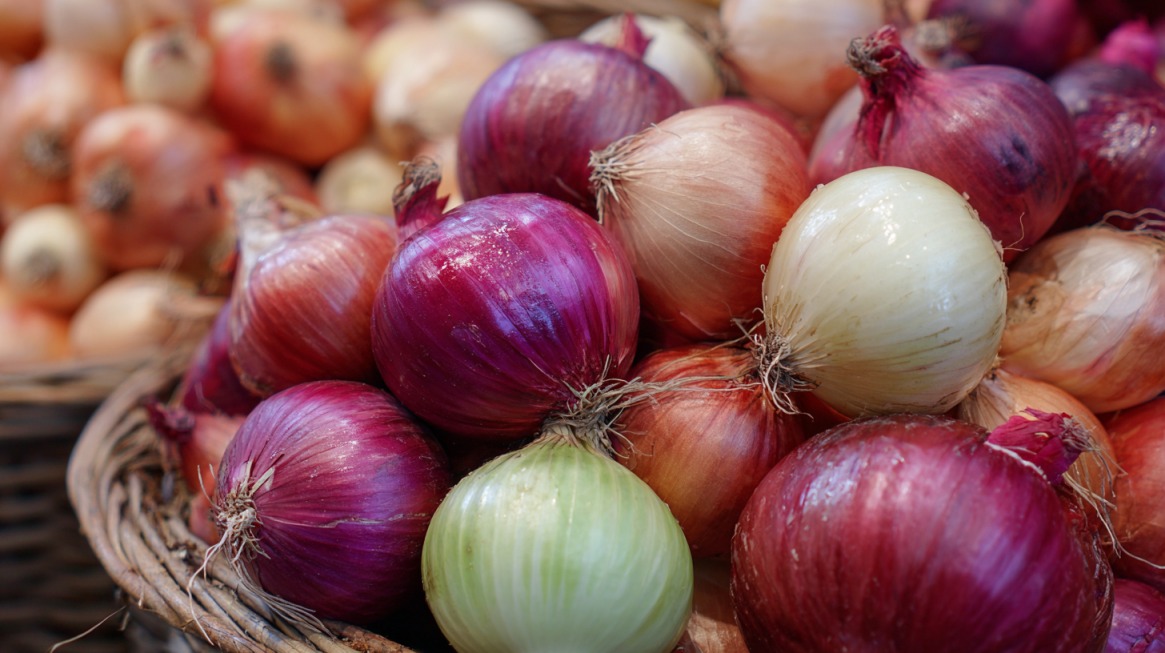Alliums are foundational ingredients that appear in countless kitchens, offering aroma, depth, and structure to a wide range of dishes. They provide the base notes that carry sauces, soups, stir-fries, and salads.
Within this family, shallots and onions often confuse because they look similar at first glance. Still, their roles are far from identical. Substituting one for the other without thought can throw off balance, leaving a dish too strong or too flat.
Every cook benefits from knowing how flavor, texture, and cooking performance differ between the two.
| Category | Onions | Shallots |
|---|---|---|
| Botanical Family | Member of alliums, cousin to shallots | Member of alliums, cousin to onions |
| Growth & Appearance | Single, rounded large bulb | Grows in clusters of smaller bulbs, teardrop/torpedo-shaped |
| Varieties | Yellow (sweet when cooked), Red (sharp, raw use), White (mild, crisp) | Shades range from pale gray to magenta |
| Flavor & Aroma | Strong, sulfur-rich, bold | Mild, sweet, with subtle garlic undertones |
| Best Uses (Flavor) | Soups, stews, braises, caramelization, grilling | Raw salads, vinaigrettes, sauces, light sautés |
| Texture in Cooking | Thicker layers, hold shape during long cooking | Thin layers, soften quickly, melt into dishes |
| Price & Availability | Inexpensive, widely available, hardy pantry staple | More expensive (2–3x), smaller, often hand-harvested |
| When to Use | For bulk, strong flavor, or budget cooking | For subtlety, delicacy, or refined dishes |
| Culinary Role | Provides structure, volume, and boldness | Adds elegance, refinement, and balance |
Appearance & Growth Differences

Visual cues are often the first way to distinguish between onions and shallots. Their growth habits and structures influence how they are harvested and eventually used in recipes.
Onions
Onions grow as single, rounded bulbs, each one larger and sturdier than a shallot. Their sheer size makes them indispensable when recipes demand volume.
- Yellow onions: Balance of sharpness and sweetness, adaptable for many cooking styles
- Red onions: Brightly colored, sharper in taste, and popular in raw applications
- White onions: Crisp and light, offering a clean flavor suited to salads and fresh salsas
Their robust form allows onions to handle extended cooking times without losing integrity, which is why they are often used in caramelized bases or hearty soups.
Shallots
Shallots develop more like garlic, producing clusters of smaller bulbs instead of a single large one. Each bulb is elongated, resembling a teardrop or slender torpedo. Under their dry outer skin, shades vary from pale gray to light magenta.
Their size and shape make them easier to measure out in small portions, which is helpful in recipes requiring fine adjustments to flavor.
Because they are milder and more compact, shallots find their place in delicate sauces, vinaigrettes, or any dish where subtlety is valued over strength.
Flavor & Aroma

Flavor differences between shallots and onions drive most of their culinary separation. Each one develops distinct chemical compounds that dictate aroma, sweetness, and pungency.
Onions
Onions are known for their sulfur compounds, which release strong aromas when cut.
- Yellow onions: Develop sweetness during cooking, excellent for caramelization
- Red onions: Retain a sharper bite, making them better suited for raw uses
- White onions: Deliver a milder crunch, ideal for fresh salads or salsa toppings
Their boldness makes onions dependable in dishes that require strength and endurance, such as braises, roasts, and soups.
Shallots
Shallots are valued for their gentle balance of sweetness and mild garlic tones. They rarely overpower and instead harmonize with surrounding flavors. Many chefs describe them as elegant additions that bring refinement without aggression.
Their flavor works best in raw or lightly cooked dishes where their delicacy can be appreciated fully.
Texture and Cooking Behavior
@kellyscleankitchen Onions vs Shallots 🧅 #cooking #cooktok #recipes #onions #shallots #cooking101 ♬ First Class – Jack Harlow
Texture can determine whether an allium blends seamlessly or stands out in chunks. Shallots and onions differ here, influencing their culinary applications.
- Shallots: Fine, thin layers collapse quickly in heat. They melt into sauces and emulsions, leaving behind flavor without noticeable pieces. Ideal for pan sauces, vinaigrettes, and toppings that benefit from smoothness.
- Onions: Thicker layers hold shape even after extended cooking. Their resilience makes them perfect for caramelization, grilling, or serving as the backbone of long-simmered dishes.
Knowing how each responds to heat avoids mismatched textures and ensures dishes achieve the intended consistency.
Price and Availability
Shopping considerations play a major role in choosing between onions and shallots. Their cost and availability often guide which one ends up in a recipe.
- Shallots: More expensive, often two or three times the price of onions. Their smaller size, slower growth cycle, and frequent hand-harvesting contribute to higher cost. They are often associated with refined cooking, particularly in French cuisine.
- Onions: Inexpensive, widely available, and extremely hardy. They are stocked in nearly every market worldwide, making them a reliable staple for daily cooking.
For many households, onions serve as the everyday workhorse, while shallots are saved for occasions where delicacy is required.
When to Use Shallots vs. Onions

Practical use depends on the dish at hand. Flavor intensity, budget, and cooking time all play roles in determining which one works best.
- A subtle, sweet flavor is desired in dressings, vinaigrettes, or refined sauces
- Preparing raw applications such as salads, pickles, or garnishes
- Quick cooking is needed, and a smooth, melt-in texture benefits the dish
Use Onions When:
- Building a base for soups, stews, or braises where volume is important
- Stretching ingredients while working with limited budgets
- Seeking bold flavor or crisp raw bite, as in tacos or fresh salsas
The Family Tree
Alliums represent one of the most widely used botanical families in cooking. They share a common ancestry but each member carries its own personality, texture, and role in the kitchen.
By looking at how different types behave, cooks can see why some alliums dominate heavy dishes while others bring subtle finishing touches.
- Onions: Bold, versatile, with varieties ranging from sweet to sharp
- Shallots: Delicate, slightly sweet, with a gentle garlic undertone
- Garlic: Strong, pungent, instantly transforms a dish with intensity
- Leeks: Softer, sweeter, and well suited to soups and gentle sautés
- Chives: Fresh, grassy flavor often used raw as a garnish
Although onions and shallots may look related, botanically they are considered cousins rather than siblings.
Both grow underground and share the papery skin, yet their internal makeup and flavor chemistry make them very different.
Treating them interchangeably risks flattening flavors, while acknowledging their individual strengths allows dishes to shine.
Why Does It Matter?
Cooking with precision means paying attention to small yet powerful details. Shallots bring refinement, sweetness, and elegance, while onions contribute strength, structure, and bold character.
Both are valuable, but each shines under different conditions. Choosing correctly enhances balance and prevents dishes from leaning too harsh or too dull.
A confident cook recognizes that two similar-looking bulbs carry distinct personalities. Respecting those differences ensures meals with depth, harmony, and impact.
Hi there, my name is Kelly Barlow and kellytoeat.com is my blog. Here, I write about various recipes I want to reccommend to readers.
I try to find the best possible recipes that can attract the attention of readers, and at the same time, I strive to write it in the most engaging manner possible.
When I was younger, I wanted to become a chef. Sadly, it wasn’t meant to be, but at the very least, I write about it.
